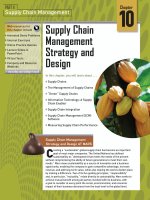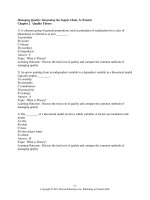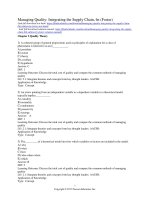Lecture Operations management: Creating value along the supply chain (Canadian edition) - Chapter 1
Bạn đang xem bản rút gọn của tài liệu. Xem và tải ngay bản đầy đủ của tài liệu tại đây (965.35 KB, 45 trang )
Chapter 1
OPERATIONS MANAGEMENT:
Creating Value Along the Supply Chain,
Canadian Edition
Robert S. Russell, Bernard W. Taylor III, Ignacio Castillo, Navneet Vidyarthi
CHAPTER 1
Introduction to Operations and Supply
Chain Management
1-1
Learning Objectives
• Describe what the operations function is and how it relates to other
•
•
•
•
•
business functions.
Discuss the key factors that have contributed to the evolution of
operations and the initiation of supply chain management.
Discuss how and why businesses operate globally and explain the
roles China and India play in the current global market.
Calculate and interpret productivity measures used for measuring
competitiveness.
Discuss the process of developing, deploying, and monitoring the
success of an operations strategy.
Organization of This Text
Learning Objectives of This Course
Lecture Outline
• What Operations and Supply Chain Managers Do
• Operations Function
• Evolution of Operations and Supply Chain
•
•
•
•
Management
Globalization and Competitiveness
Operations
Strategy and Organization of the Text
Learning Objectives for This Course
What Operations and Supply Chain
Managers Do
• What is Operations Management?
design, operation, and improvement of productive systems
• What is Operations?
a function or system that transforms inputs into outputs of greater
value
• What is a Transformation Process?
a series of activities along a value chain extending from supplier to
customer
activities that do not add value are superfluous and should be
eliminated
Transformation Process
• Physical: as in manufacturing operations
• Locational: as in transportation or warehouse
•
•
•
•
operations
Exchange: as in retail operations
Physiological: as in health care
Psychological: as in entertainment
Informational: as in communication
Operations as a Transformation Process
1-6
Operations Function
Operations
Marketing
Finance and
Accounting
Human
Resources
Outside
Suppliers
1-7
How is Operations Relevant
to my Major?
Accounting
“As an auditor you must understand the
fundamentals of operations
management.”
Information
Technology
Management
“IT is a tool, and there’s no better place to
apply it than in operations.”
“We use so many things you learn in an
operations class—scheduling, lean
production, theory of constraints, and tons
of quality tools.”
1-8
How is Operations Relevant
to my Major?
Economics
Marketing
Finance
“It’s all about processes. I live by
flowcharts and Pareto analysis.”
“How can you do a good job marketing a
product if you’re unsure of its quality or
delivery status?”
“Most of our capital budgeting requests
are from operations, and most of our
cost savings, too.”
1-9
Evolution of Operations and Supply Chain
Management
Craft production
process of handcrafting products or services for
individual customers
Division of labor
dividing a job into a series of small tasks each
performed by a different worker
Interchangeable parts
standardization of parts initially as replacement parts;
enabled mass production
1-10
Evolution of Operations and
Supply Chain Management
Scientific management
systematic analysis of work methods
Mass production
high-volume production of a standardized product
for a mass market
Lean production
adaptation of mass production that prizes quality
and flexibility
1-11
Historical Events in Operations Management
1-12
Historical Events in
Operations Management
1-13
Historical Events in
Operations Management
1-14
Historical Events in
Operations Management
1-15
Historical Events in
Operations Management
1-16
Evolution of Operations and Supply
Chain Management
Supply chain management
management of the flow of information, products, and services across a
network of customers, enterprises, and supply chain partners
1-17
Globalization
Why “go global”?
favorable cost
access to international markets
response to changes in demand
reliable sources of supply
latest trends and technologies
Increased globalization
results from the Internet and falling trade barriers
1-18
Hourly Compensation
1-19
GDP per Capita
1-20
Trade in Goods, % of GDP
1-21
Productivity and Competitiveness
Competitiveness
degree to which a nation can produce goods and
services that meet the test of international markets
Productivity
ratio of output to input
Output
sales made, products produced, customers served,
meals delivered, or calls answered
Input
labor hours, investment in equipment, material usage, or
square footage
1-22
Measures of Productivity
1-23
Cunningham Industries
1-24
Productivity Growth
1-25









